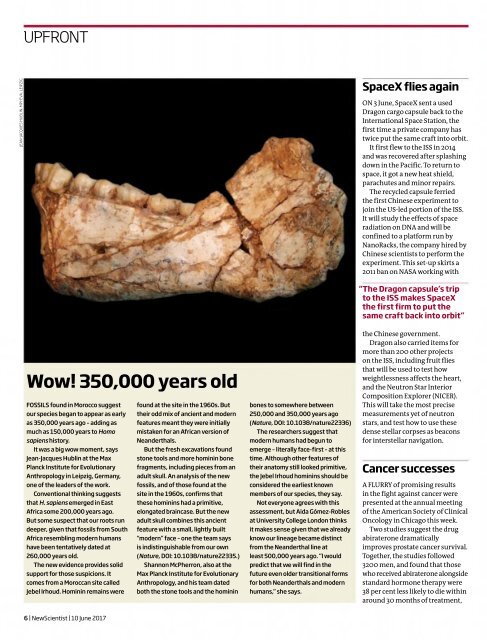New Scientist – June 10 2017
Create successful ePaper yourself
Turn your PDF publications into a flip-book with our unique Google optimized e-Paper software.
UPFRONT<br />
JEAN-JACQUESHUBLIN,MPI-EVA,LEIPZIG<br />
SpaceX flies again<br />
ON 3 <strong>June</strong>, SpaceX sent a used<br />
Dragon cargo capsule back to the<br />
International Space Station, the<br />
first time a private company has<br />
twice put the same craft into orbit.<br />
It first flew to the ISS in 2014<br />
and was recovered after splashing<br />
down in the Pacific. To return to<br />
space, it got a new heat shield,<br />
parachutes and minor repairs.<br />
The recycled capsule ferried<br />
the first Chinese experiment to<br />
join the US-led portion of the ISS.<br />
It will study the effects of space<br />
radiation on DNA and will be<br />
confined to a platform run by<br />
NanoRacks, the company hired by<br />
Chinese scientists to perform the<br />
experiment. This set-up skirts a<br />
2011 ban on NASA working with<br />
“The Dragon capsule’s trip<br />
to the ISS makes SpaceX<br />
the first firm to put the<br />
same craft back into orbit”<br />
Wow! 350,000 years old<br />
FOSSILS found in Morocco suggest found at the site in the 1960s. But<br />
our species began to appear as early their odd mix of ancient and modern<br />
as 350,000 years ago <strong>–</strong> adding as features meant they were initially<br />
much as 150,000 years toHomo mistaken for an African version of<br />
sapiens history.<br />
Neanderthals.<br />
It was a big wow moment, says<br />
But the fresh excavations found<br />
Jean-Jacques Hublin at the Max<br />
stone tools and more hominin bone<br />
Planck Institute for Evolutionary fragments, including pieces from an<br />
Anthropology in Leipzig, Germany, adult skull. An analysis of the new<br />
one of the leaders of the work.<br />
fossils, and of those found at the<br />
Conventional thinking suggests site in the 1960s, confirms that<br />
thatH.sapiens emerged in East<br />
these hominins had a primitive,<br />
Africa some 200,000 years ago. elongated braincase. But the new<br />
But some suspect that our roots run adult skull combines this ancient<br />
deeper, given that fossils from South feature with a small, lightly built<br />
Africa resembling modern humans “modern” face <strong>–</strong> one the team says<br />
have been tentatively dated at<br />
is indistinguishable from our own<br />
260,000 years old.<br />
(Nature, DOI: <strong>10</strong>.<strong>10</strong>38/nature22335.)<br />
The new evidence provides solid Shannon McPherron, also at the<br />
support for those suspicions. It<br />
Max Planck Institute for Evolutionary<br />
comes from a Moroccan site called Anthropology, and his team dated<br />
Jebel Irhoud. Hominin remains were both the stone tools and the hominin<br />
bones to somewhere between<br />
250,000 and 350,000 years ago<br />
(Nature, DOI: <strong>10</strong>.<strong>10</strong>38/nature22336)<br />
The researchers suggest that<br />
modern humans had begun to<br />
emerge <strong>–</strong> literally face-first <strong>–</strong> at this<br />
time. Although other features of<br />
their anatomy still looked primitive,<br />
the Jebel Irhoud hominins should be<br />
considered the earliest known<br />
members of our species, they say.<br />
Not everyone agrees with this<br />
assessment, but Aida Gómez-Robles<br />
at University College London thinks<br />
it makes sense given that we already<br />
know our lineage became distinct<br />
from the Neanderthal line at<br />
least 500,000 years ago. “I would<br />
predict that we will find in the<br />
future even older transitional forms<br />
for both Neanderthals and modern<br />
humans,” she says.<br />
the Chinese government.<br />
Dragon also carried items for<br />
more than 200 other projects<br />
on the ISS, including fruit flies<br />
that will be used to test how<br />
weightlessness affects the heart,<br />
and the Neutron Star Interior<br />
Composition Explorer (NICER).<br />
This will take the most precise<br />
measurements yet of neutron<br />
stars, and test how to use these<br />
dense stellar corpses as beacons<br />
for interstellar navigation.<br />
Cancer successes<br />
A FLURRY of promising results<br />
in the fight against cancer were<br />
presented at the annual meeting<br />
of the American Society of Clinical<br />
Oncology in Chicago this week.<br />
Two studies suggest the drug<br />
abiraterone dramatically<br />
improves prostate cancer survival.<br />
Together, the studies followed<br />
3200 men, and found that those<br />
who received abiraterone alongside<br />
standard hormone therapy were<br />
38 per cent less likely to die within<br />
around 30 months of treatment,<br />
6 | <strong>New</strong><strong>Scientist</strong> | <strong>10</strong> <strong>June</strong> <strong>2017</strong>


















